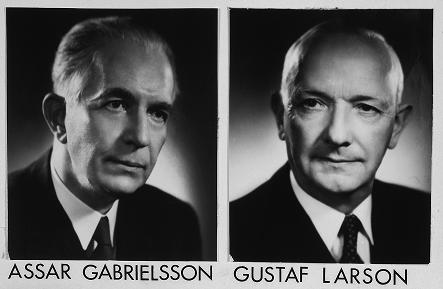
On December 16th, 1925 a famous agreement is signed between Assar Gabrielsson and Gustaf Larson, more than a year after an oral agreement was made at restaurant Sturehof in Stockholm. The agreement is that Larson, receiving some compensation that is to be paid upon completion and only under certain circumstances, will construct a new car from scratch. The two had previously worked together at Swedish ball bearing maker SKF in Gothenburg and both had considered producing a Swedish car for several years. A car manufactured from the world renowned Swedish steel would be of higher quality and would successfully be able to compete with the American cars on the market. The roads in Sweden at the time were in comparably miserable condition and foreign cars did not always work very well with the climate in Scandinavia. Assar Gabrielsson held a Master of Finance degree from the Stockholm School of Economics and was at the time Head of Sales at SKF. Gustaf Larson held a Master of Science degree in Mechanical Engineering from the Royal Institute of Technology and was at the time Technical Director at manufacturing company Galco (G.A. Lindquist & Co.) on Hälsingegatan 41 in Stockholm, but had previously held the position Head of Construction at SKF.
Sections:
Volvo Is Founded
The Early Years
The Amazon Takes Shape
The Prototypes
Production Start
International Debut
Product Development
Volvo Is Founded
Gabrielsson and Larson orally agree already in August 1924 over a crayfish dinner at the named restaurant and the project is to be financed privately by Gabrielsson with some support mainly on practical issues (including the share capital of SEK 200 000 plus credits amounting to SEK one million – a substantial sum at the time) from an otherwise not very interested corporate management at SKF. The project did initially not even have a name and the first prototypes are registered as ”GL” or ”Larson” after Gustaf Larson. From 1926, an inactive company within the SKF group is used: Volvo.
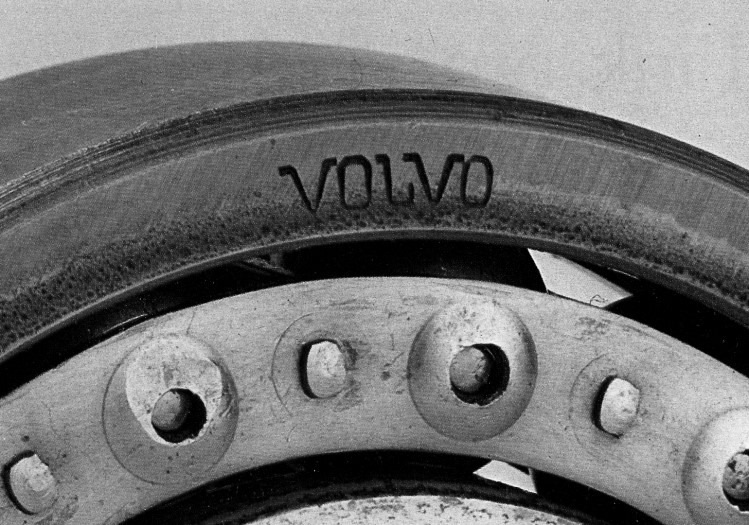
The name, which can be translated from Latin as I roll, was registered by SKF already in 1915 and was originally intended to be used for a special series of simpler deep groove ball bearers for the rapidly growing American automotive industry, but remained resting after a decision by SKF’s new CEO Björn Prytz in 1919 that all the company’s products should carry the company name (the stock with the Volvo ball bearers were sold for yet a couple of years).
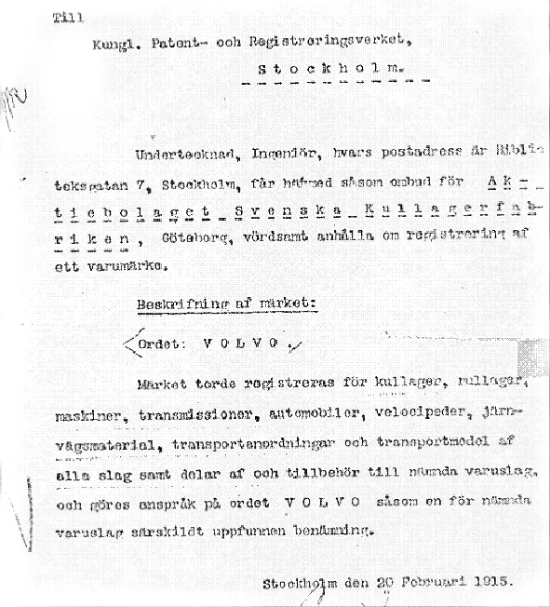
The work with constructing the first passenger car from Volvo, ÖV 4, is mostly conducted in the Larson family residence on Rådmansgatan 59 in Stockholm – in the children’s bedroom to be more precise. Larson can of course not work on the car project during regular office hours but is assisted by several young engineers in the construction work, including Jan G. Smith and Henry Westerberg. Westerberg later became the first Volvo employee and is still today the longest serving Volvo employee with 55 years in the company. Several of Volvo’s more prominent employees have thorough experience of automotive construction and manufacturing from the USA. The result from the construction work is ten prototypes, nine open-top and one covered, whose chassis are all manufactured at Galco during the spring of 1926 and whose bodies are finished at AB Freyschuss a mile or so away on Sveavägen in Stockholm. Production is started during the fall and is located to SKF’s redundant facilities in Lundby on Hisingen outside Gothenburg. Production was also considered in Stockholm, Örebro and Eskilstuna. The first car, an ÖV 4, leaves the factory on April 14th 1927, a date that has come to mark the founding of Volvo. The story of how Volvo’s first series produced car had to leave the factory in reverse gear is true. The differential gear had been incorrectly mounted in the rear axis (an error that took less than ten minutes to correct).
The car is reviewed on Monday, April 25th 1927 in Swedish press who strikingly describe it as good but not remarkable, something that most would agree is true about Volvo’s cars still to this day. The first series produced car is put on display at the freshly recruited Sales Director Ernst Grauer’s show room at Brunkebergstorg in Stockholm, where it attracts large crowds. Volvo make a big number of the fact that only the lights and the engine’s ignition are foreign (Bosch) while everything else come from domestic Swedish suppliers. The 1.9 liter four cylinder side valve engine of 30 hp comes from Pentaverken, the three step unsynchronized gearbox from Köpings Mekaniska Verkstad, the body and all of its wood framing from Åtvidabergs Fabriker, the radiator from Hermanssons in Stockholm, the tires from Gislaved, and so on.
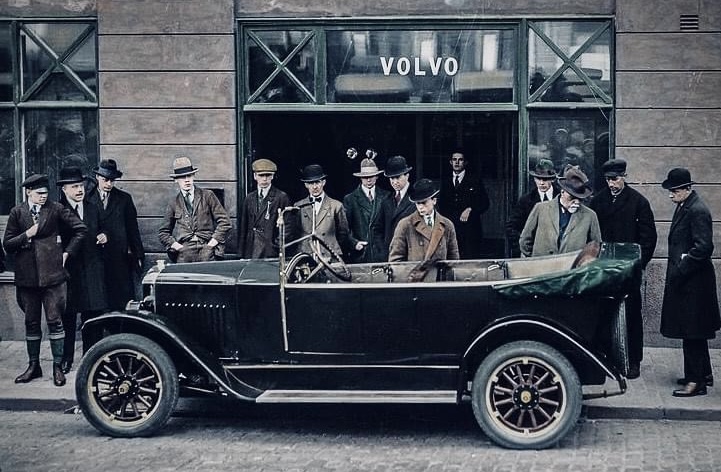
The Early Years
The sales of Volvo cars is initially however slow, very slow, and after some time SKF considers selling the business. Charles Nash, owner and founder of the Nash factories, is invited to Sweden from USA to discuss a possible purchase of Volvo. Assar Gabrielsson calls Björn Prytz on the same morning that Nash is to arrive in Gothenburg and offers to invest his own capital in Volvo (capital that he in part got from Volvo for the work with the prototypes) with less of a pretense to reimbursement than SKF had. After a telephone conference the SKF board decides not to sell Volvo to Nash. Volvo soon expands the business to also include the manufacturing of trucks. The trucks are until the 1950s the most profitable part of the company and are the key to its early success. The cars continue to sell poorly and production is modest. The first real success doesn’t come until the 1944 introduction of the Volvo PV 444.
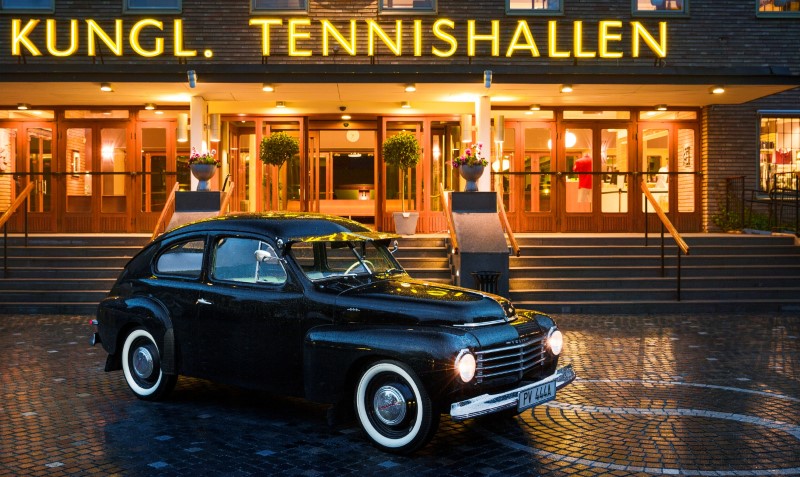
Until now, none of the passenger cars manufactured by Volvo have been produced in more than 2,000 units. When the PV 444 is replaced by the PV 544 in 1957 it has been produced in more than 200,000 units. In the era that follows World War II (in which Sweden did not participate, leaving essentially all of the country’s production assets intact), the PV 444 is the first real family car to come out of Volvo. From a sales perspective it is a huge success.
The Amazon Takes Shape
In the early 1950s Volvo’s CEO Assar Gabrielsson decides that a worthy successor to the successful PV 444 needs to be built and during the first years of the decade Volvo is busy developing several prototypes. Some of them never left the drawing table, some were built in smaller or even in full-size models of wood or clay and some were built as driveable prototypes that were registered for traffic.
One young Jan Wilsgaard is hand picked and hired by Volvo in June 1950, only 20 years old. It happened as he studied sculpturing at the Handicraft Society School in Gothenburg when one day during class his teacher, famous artist Nils Wedel, suddenly says ”Volvo is looking for a designer. What do you think about that, Jan?” Neither design nor industrial design existed as a degree in Sweden at the time and instead you had to first become an interior architect and then study sculpturing, which is exactly what Wilsgaard did. Assar Gabrielsson is known to have expressed ”is it really necessary with a designer?”, but management knew that the company needed to focus more on design going forward and less on gut feeling.
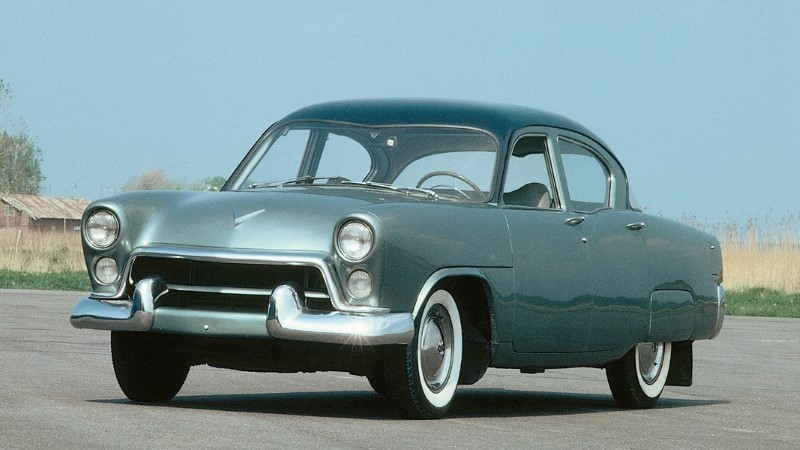
Wilsgaard’s first assignment at Volvo involves modifications on the PV 60 but quite soon he is working independently with the design of the prototype ”Philip”, one of several prototypes he worked on to find a successor for the PV 444. That Volvo had the tradition of naming its projects after names in the name-day calendar what not something new – they did this already with their very first car, ”Jakob” – but at this time the British Royal family were on the call and in Swedish press the conclusion was the project name ”Philip” at Volvo was somehow related to this. During 1952 Wilsgaard is working on the prototype P 179, which Swedish pressed named ”Margret Rose”. These prototypes were both approved but leads nowhere.
Two driveable prototypes from projects that were later discarded but came to inspire the design of the Volvo Amazon were Gösta Wennberg’s ”Elisabeth” from 1952 with a driveable prototype ready by 1953 and the successor ”Elisabeth II”. These were also names that Swedish press made up. Wennberg was a Swedish businessman with a strong interest in cars who basically wanted to sell a predecessor of the PV 444 to Volvo that he himself had come up with together with Ghia Aigile in Switzerland and Vignale in Italy and that was built by Allemanno in Turin, Italy. ”Elisabeth” was based on the chassis of the PV 445 but had too little room for the passengers (it has been said that Gabrielsson could barely get in to the rear seat of the car) of the prototype was rejected by Volvo. The successor ”Elisabeth II” from 1954, based on the chassis of PV 444, was a second attempt by Wennberg built by Vignale with a body in aluminum and with several of the shortcomings pointed out by Volvo corrected, but when calculating on the business case it came out as far too expensive to produce so also this project was discarded.

During 1954 Volvo management hands out three new and different assignments of which Wilsgaard is given one. One of the other two is given to Helmer Pettersson and results in a proposal called PV 454. The last assignment is given to Rustan Lange whos proposal is called ”65”. ”Work freely, but come up with something new” is the instruction given.
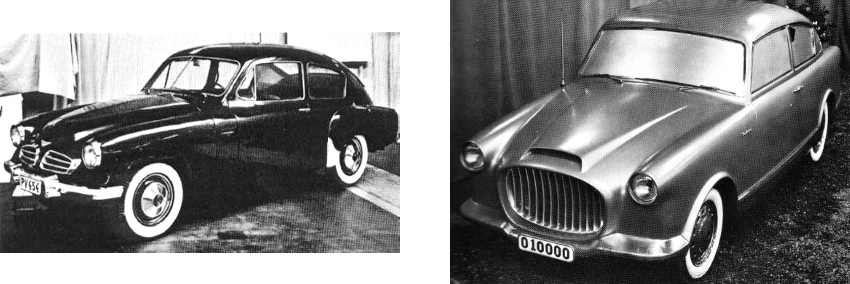

It was said afterwards that the atmosphere was very strained when the assignments were to be presented to management. Gabrielsson had vouched for one of the other assignments, ”The one from Olofström” as Pettersson’s PV 454 is called, which turns out to be so ugly that it is immediately dismissed. Larson, who didn’t get along with Pettersson, vouched for Lange’s ”65” and Wilsgaard’s proposal ”55” but these are also rejected. In the end Wilsgaard is given the new and impossible task to to come up with a feasible solution based on his own and on the ugly one from Olofström.
With the new task came strict requirements including that the car must have four doors, be based on the chassis from the PV 444, have the same wheel base and preferably not weigh more. Wilsgaard protests but this is ignored. During regular office hours he works on the assignment given to him where he base his work on several of the existing solutions and projects, including Wennberg’s ”Elisabeth”, Helmer Pettersson’s PV 454 and his own ”55” and P 179. But during non-office hours he works on his own proposal. The design of what is to become Volvo Amazon therefore takes place during early mornings, lunch breaks, evenings and weekends (in the 1950s the regular work week in Sweden included half day of Saturday). Wilsgaard finds inspiration from contemporary Italian, British and American car design and during a relatively short period of time in 1953 comes up with two full scale clay models: one in accordance with the requirements given by management and one – placed in one of the corners of his workplace – of his own design. His boss checks in regularly and more often than not specifically towards the corner in which the model of what later will be known as the Volvo Amazon is placed.


Many years later, Wilsgaard described how Gabrielsson sits with his back turned towards the model in the corner, glaring at the clay model meeting the requiremets and, as usual, sucking on his cigar. He is facing the door when suddenly Gustaf Larson appears. ”Damn nice car” says Larson looking straight above Gabrielsson’s head towards the corner. Gabrielsson swivels his chair, stares for a while and finally says: ”Yeah, it looks alright but it’s good looking like a pin-up girl. That’s not good, it should be uglier, as it could draw attention.” Assar Gabrielsson held the firm belief that cars should be discrete and preferably black. The sales director is called in and he also votes for the model in the corner. The design that Wilsgaard had worked on in his spare time is for its time very modern and Volvo management needs three weeks before Jan Wilsgaard – 23 years old – is given the OK to proceed with his own proposal and as he sees fit. The only requirement management has is that it should have four doors. The result is Volvo’s first pontoon bodied car and a design that is still attractive today. In fact, several design elements from the Volvo Amazon can be found on Volvo cars of today.
The Prototypes
In 1954 Volvo starts the development of prototypes and the new model is given a name: Amason. The name Amason had been chosen because of its original meaning. If Volvo’s iron mark logo associated to things masculine, the word amason did the opposite. According to Greek mythology, the amazons were female warriors who fought with bow and arrow. The legend has it that they had their right breast removed in order to be able to better use their deadly weapons (Greek a mazos = breastless). These powerful women fought on the Trojan side against the Greeks during the Trojan war. The model name was controversial at Volvo, despite the fact that it was CEO Gunnar Engellau’s idea, and was not established fully until after the summer of 1956 (by then slightly changed to the more internationally usable Amazon).
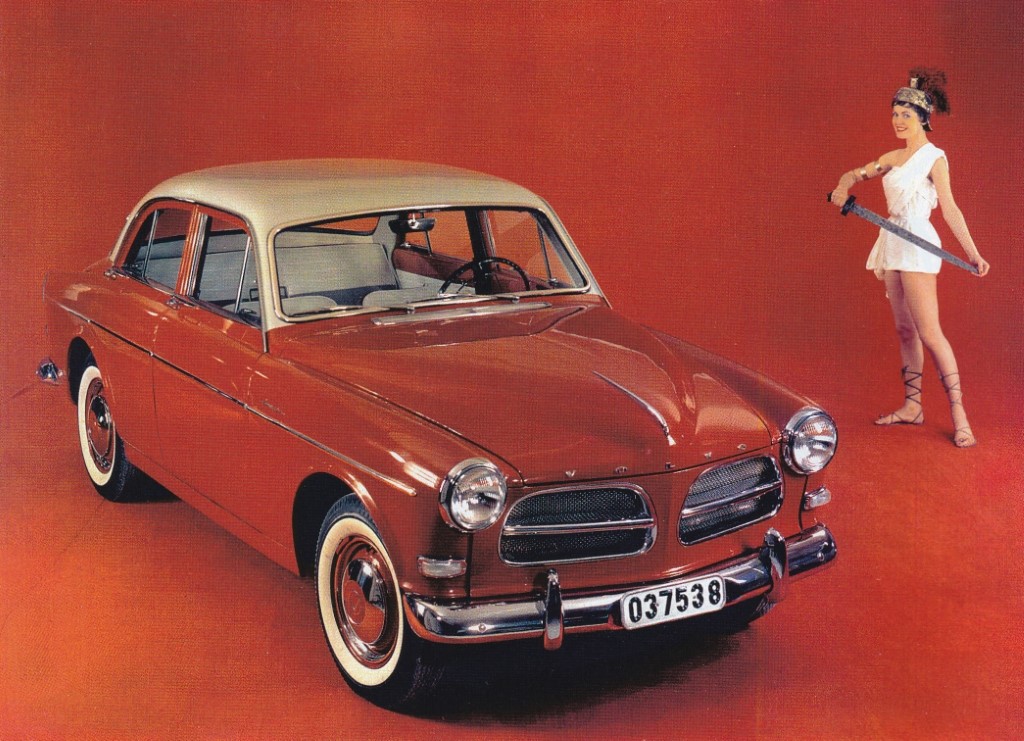
The early promotional picture from Volvo above shows a very modest amazon, a woman in classic Greek dress and equipped with a sword and a shy smile.
Volvo announce working on a new car in February 1956 but sit on the details. All Volvo admits is that they are working on a bigger and roomier car than the PV 444 that will have four doors and be more expensive than its predecessor. No word about launching date or engine choice. Naturally, speculations start more or less immediately including rumors of the first deliveries starting on August 1st, 1956 and that the car will get a straight six engine or even a V8.
In a letter to the Swedish press dated Gothenburg April 7th 1956 and signed by Assar Gabrielsson (and started with a note on that the material in the letter may be published earliest on Monday April 9th 1956), Volvo announce that one unit of their new and bigger passenger car now is ready and placed at the disposal of the technicians for test driving. Before construction and design has been tested and finalized Volvo will not publish any additional data on the car and it is also stated that it will not be possible to deliver the car during the year of 1956. Volvo also write that the car will add to the company’s line of passenger cars so that they on top of the PV 444 can offer the customers a bigger car, and that based on the cost of material at the time the car is likely to be priced at SEK 12,500 but that the exact price can be given only when the tests have been finalized and sales can start. Picture material is included with the letter, probably in the shape of the brochure RK 6112 korr.
The two-tone finish is a detail that draws a lot of attention when these first official pictures of this first prototype, called X1, are published a few days later. X1 is bluegreen with greybeige top and has white wall tires. The car is registered for traffic with license plate O60010 on April 10th, 1956 and had up until now only been driven shorter distances in the Lundby factory yard. Early pictures taken before April 10th shows it with license plate O52338 which belonged to a PV 444 that Volvo at the time used for test purposes.

Already on the day after the presentation of the first pictures of X1, the car is taken on its first longer test drive. Along on the journey are Volvo’s Production Manager Tor Berthelius and two young associates named Gerhard Salinger and Rune Gustavsson. The trip goes – without escort – north from Gothenburg to Norway, where the Amazon for the first time is tested in right-hand traffic (X1 was left hand drive). In the trunk are two winter tires that are fitted on the rear wheels when needed, as late winter Norway allowed testing the car on winter roads. The car turns out to perform well and the trip ends back in Gothenburg without any major incidents. Somewhat surprisingly, the car did not draw much attention during the journey. The remarks are mainly that the car is slightly oversteered and that the noise level is too high, both which are adjusted after the first production run. The picture below is one of few known of the X1 and was taken by Tor Berthelius in Norway. From the left is Rune Gustavsson and Gerhard Salinger.

On the inside, the X1 had a white dash top on the instrument panel and on the doors except for the section above the speedometer which was black, white frame around the windscreen, round horn ring on the steering wheel and the black field above the steering wheel center (below on the production cars). Other differences were ”Volvo”-text in different style on the steering wheel and on the radio plate, textile floor mats instead of rubber, black gear shifter knob (i.e. no ”V”), etc. On the outside, also the door arches were painted in the color of the top (greybeige). This was changed on the production cars as it would become too expensive. The wheel knobs were of a rounder and different design and had a different center ”V”. It had different shaped position lights which were faced front and did not bend around the corners, it lacked the chromed grille net and had no badges on the body, but had VOLVO letters in the rear bumper mid section (between the horns). The X1 was tested hard in different conditions in continental Europe during the summer of 1956 and was scrapped by Volvo on December 1st, 1956. The very first Volvo Amazon sales brochure (RK 6112 korr) shows both exterior and interior pictures of the X1. In a later edition (RK 6112 III) of the same sales brochure the pictures on the first and last pages are of X1 while the other pictures have been replaced by pictures of X2.
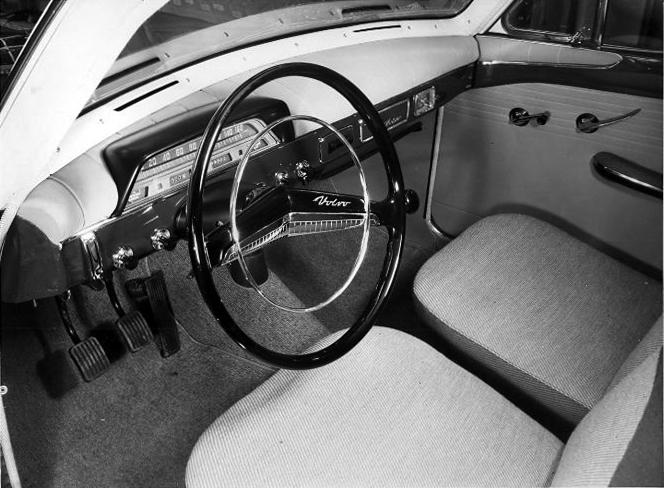
A second prototype, named X2, is developed during the early summer of 1956. X2 was red with white top and white wall tires. The pictures below are of the X2. Another color photo of the engine compartment of the X2 reveals that it had a slightly modified B4 B engine, which makes sense as the development of the B16 engine was not finished at the time. Because X1 was X2’s predecessor, it is reasonable to assume that also the X1 had a B4 B under the hood. The differences between the B4 B and the B16 A are very small and shouldn’t have affected the test runs to any bigger extent. X2 was registered for traffic on June 11th, 1956 and is together with X1 the only two Volvo Amazons of model year 1956.
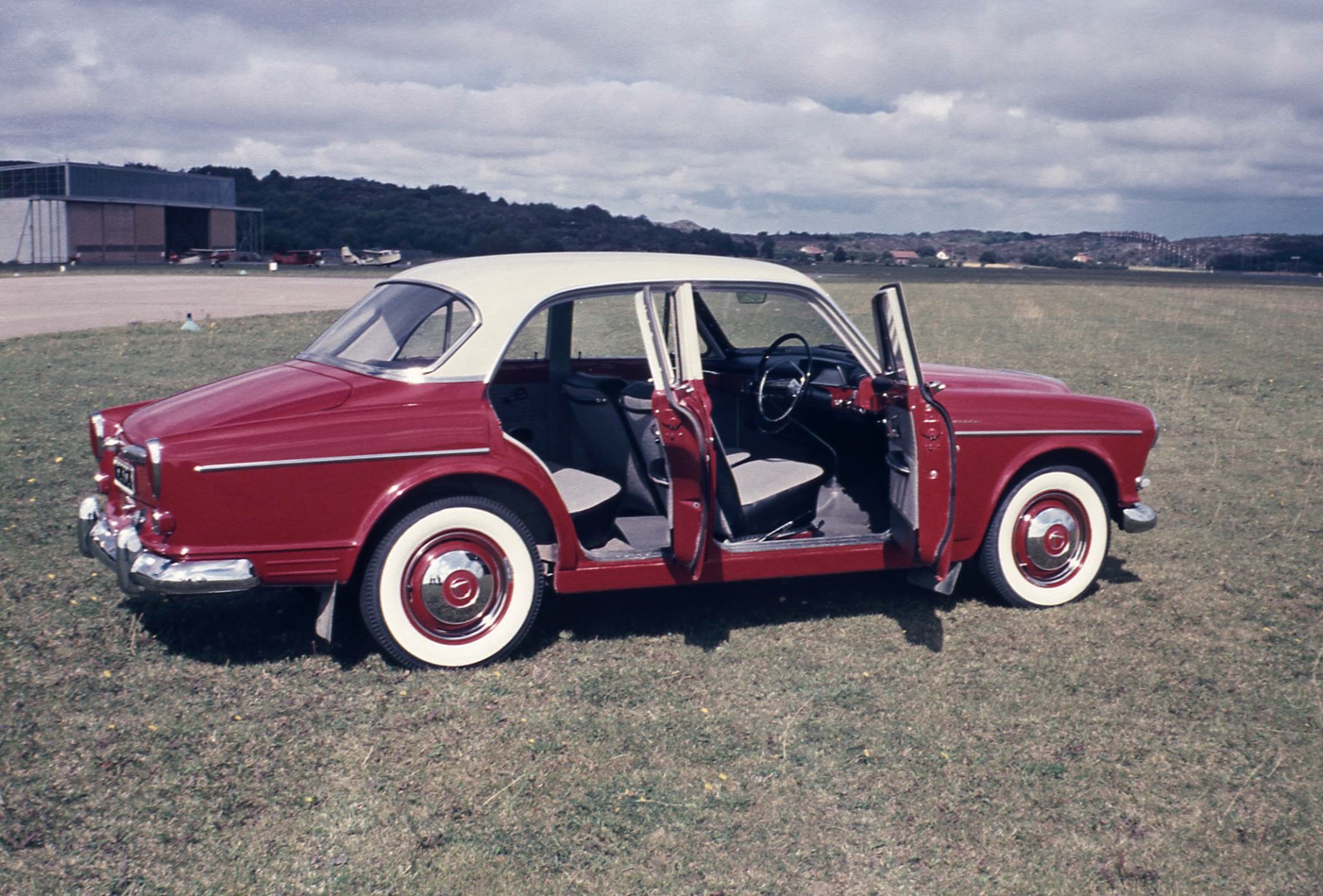
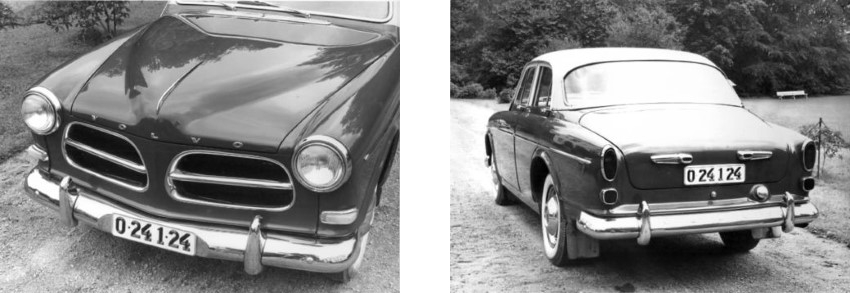
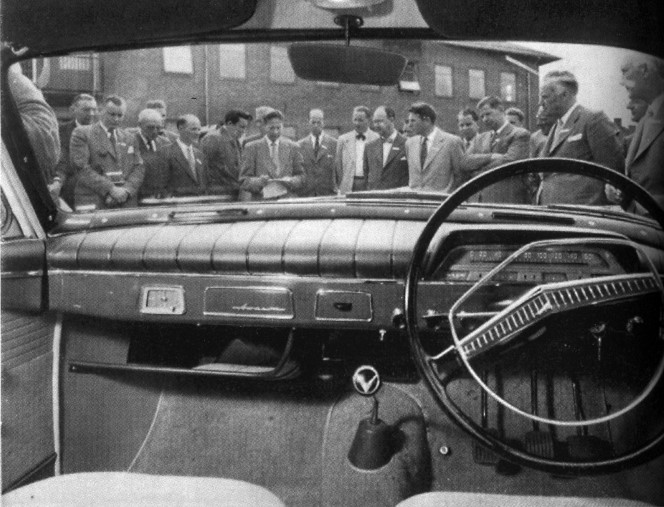
On Friday, August 3rd 1956 the new Volvo Amazon is shown to an enthusiastic crowd of Volvo dealers at a conference in Skövde. The Amazon is introduced as a four-door model and is given its characteristic appearance with a split grille, curved pontoon wings and relatively large wheels. The car on display is X2. It has chassis number 2, features right-hand drive and two-tone finish. It differed from the upcoming production version on a number of details, both on the outside and on the inside but was more like the production cars than the X1 was. The pictures in this Swedish sales brochure are of X2. X2 was later used as a company car by Rune Gustavsson before being sold to a private person outside Volvo in June 1958. Until it was scrapped on November 13th, 1967 the X2 had ten or so different owners.
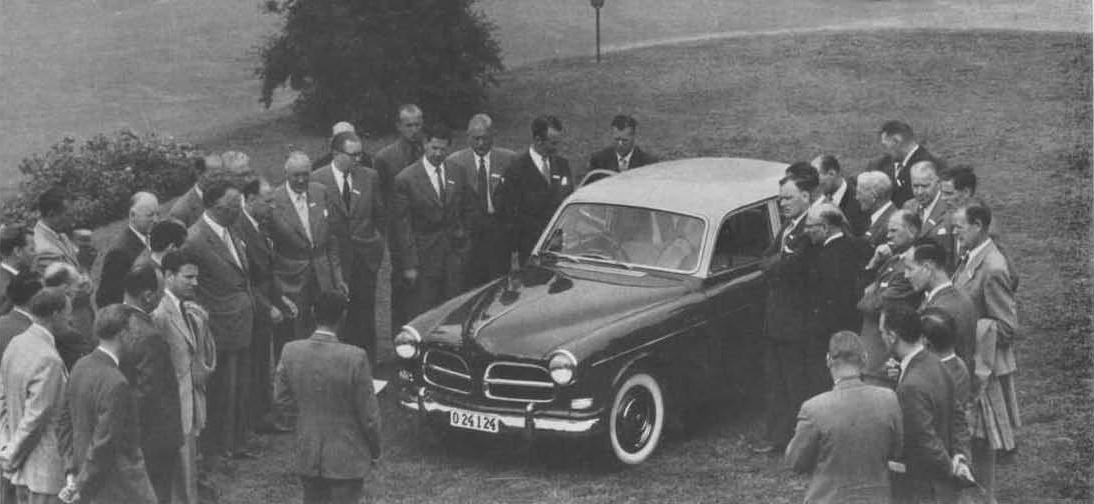
The public has to wait almost a month until the Amazon is finally introduced in Örebro the first weekend in September 1956. Below is an ad published on Friday, August 31st and an article published on September 1st – both from Nerikes Allehanda and related to the event.
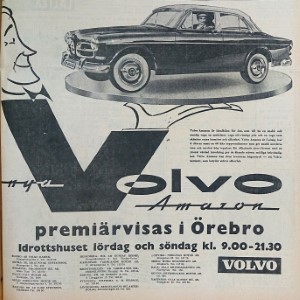 | 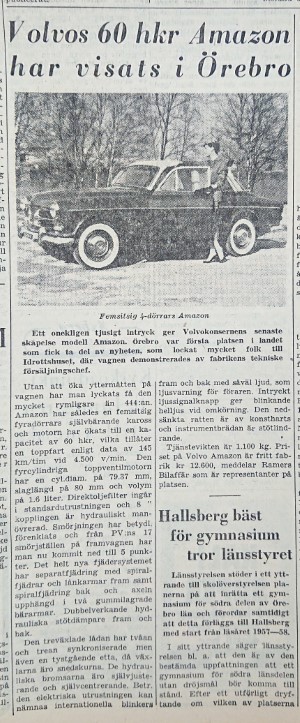 |
Production Start
Series production of the Volvo Amazon starts by the end of August 1956, now with a new series of chassis numbers, but the production pace is low and the first car is not noted as ready for delivery until October 24th the same year. The first cars are officially intended as show room cars, although this seems like a poor explanation (given the founders’ profit interest and the way they have run the company so far) to cover up poor sales. It isn’t until more than half a year later that the first car is delivered to a paying customer in late February, early March 1957 and by the end of the same year not more than 3,100 units have been produced. Limited production capacity together with initial quality problems plus a significantly higher (35%) price than the popular PV 444 lead to a poor interest from the public. In addition, Amazon buyers had to put up a down payment of SEK 4,000 which was almost a third of the total price. A new Volvo Amazon is prized at SEK 12,600 ex works Gothenburg, i.e. ready for delivery at the Lundby plant – on top of that comes the reseller’s margin.
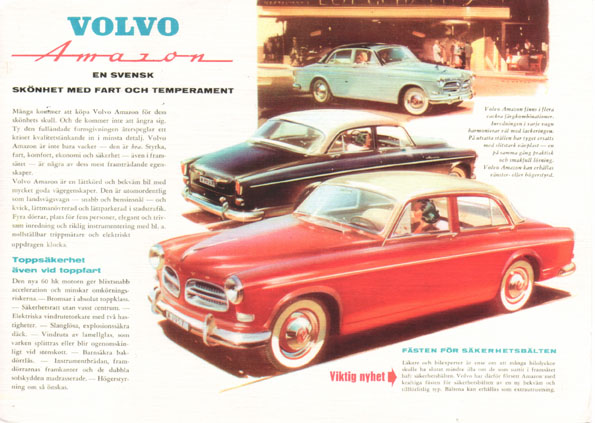
Technically the Volvo Amazon is significantly better than its predecessor PV 444 and also in comparison with its competitors. It’s also good looking and attractive in its design. The Volvo Amazon has a self-supporting construction with engine in front and drive in back. The body is completely unitized in a fully-welded construction which has been given a thorough anti-rust treatment. The instrumentation is new and different. For the first time, Volvo supplied cars with two-tone color combinations. The Amazon is similar to its predecessor in several areas, but because of the higher weight (220 lbs heavier than the PV 444), Volvo eventually decides to drill wider the B4 B engine used in the PV 444 to 97 CID (1,583 cm3). The engine plans had consisted of several alternatives, including a small V8 and a straight six. The new B16 engine is armed with one Zenith 34 VN carburetor and has an output of some 60 hp (DIN) / 66 hp (SAE). Not only the engine has its origin in the PV 444 – Volvo also uses the 6V electrical system, the three speed H6 gearbox and the chassis of the PV 444 for the Amazon. The H6 gearbox was soon to be replaced as already at that first show in Skövde there were some grumble about the lack of a fourth gear. The parking brake is placed between the door and the seat on the driver side to allow for bench type front seat and steering wheel lever gearbox (which Volvo is not able to accomodate until model year 1961, with the D body). The Amazon is a little more vain than the PV 444 and – above all – already from the very start a safety car. The Amazon is equipped with dash pad and factory installed fittings for seat belts. The Amazon is a robust and reliable car – that’s why so many are still rolling.
International Debut
The international debut for the Volvo Amazon takes place in October 1956 at the London Earl’s Court car exhibit, where the right hand steered prototype X2 is displayed but it is yet some time until foreign sales really start to grow. Additional problems appear when it turns out that German moped manufacturer Kreidler just has launched a moped called Amazone, has already registered the name and now claims the sole right to it. In the settlement between the companies, Volvo is allowed to use the name Amazon on the Scandinavian market but not anywhere else. Volvo Amazon is therefore sold under the name Volvo 121 (later also Volvo 122 S and Volvo 123 GT) outside Scandinavia. The Kreidler moped Amazone was discontinued in 1959.
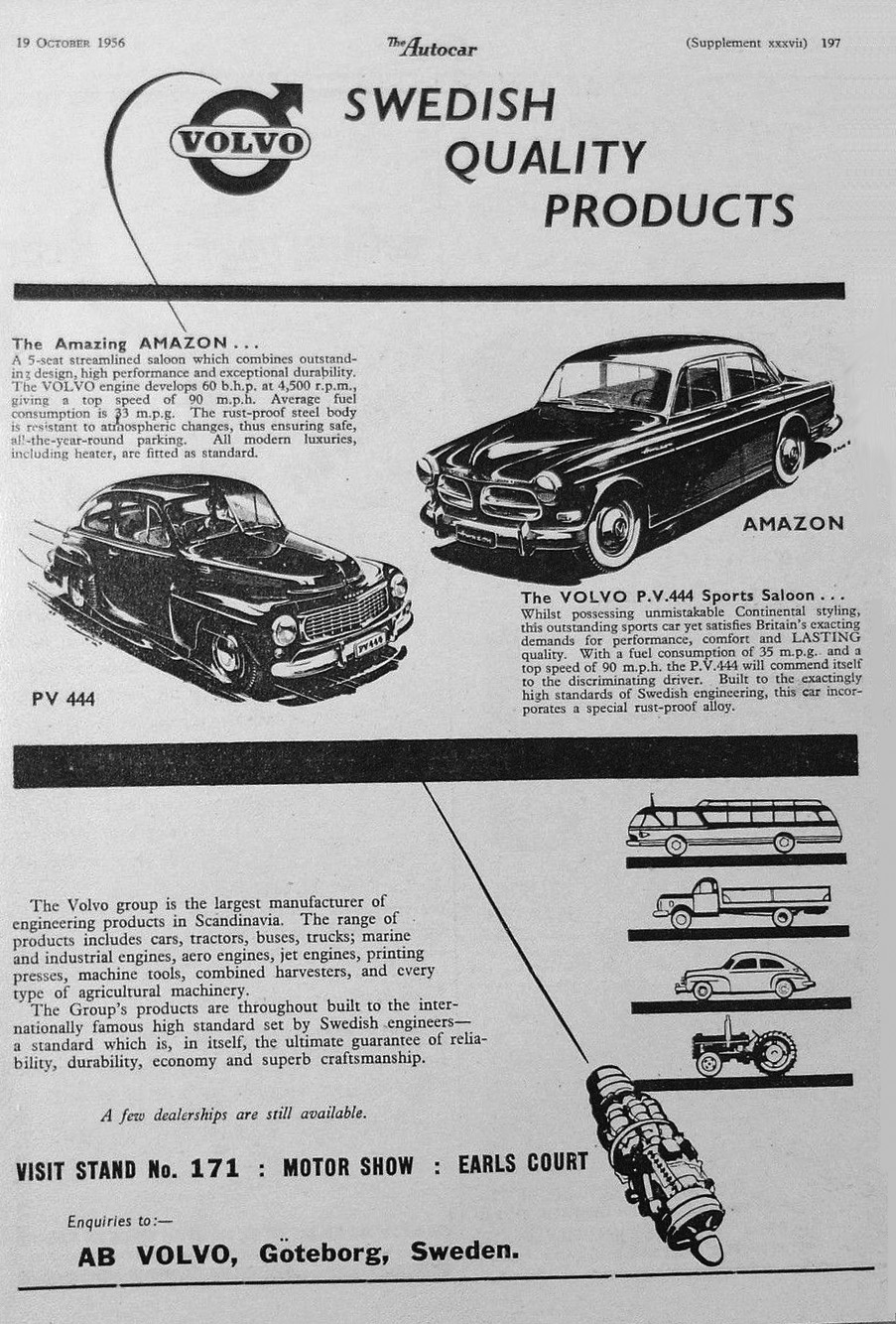
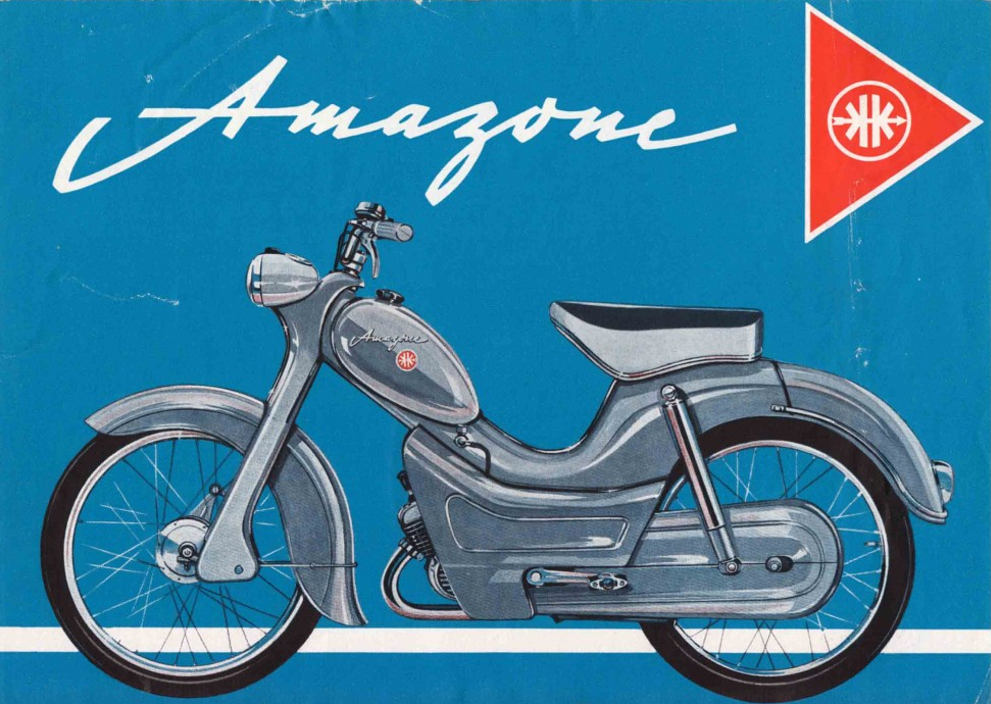
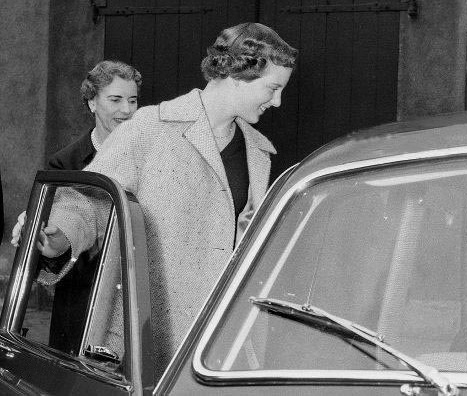
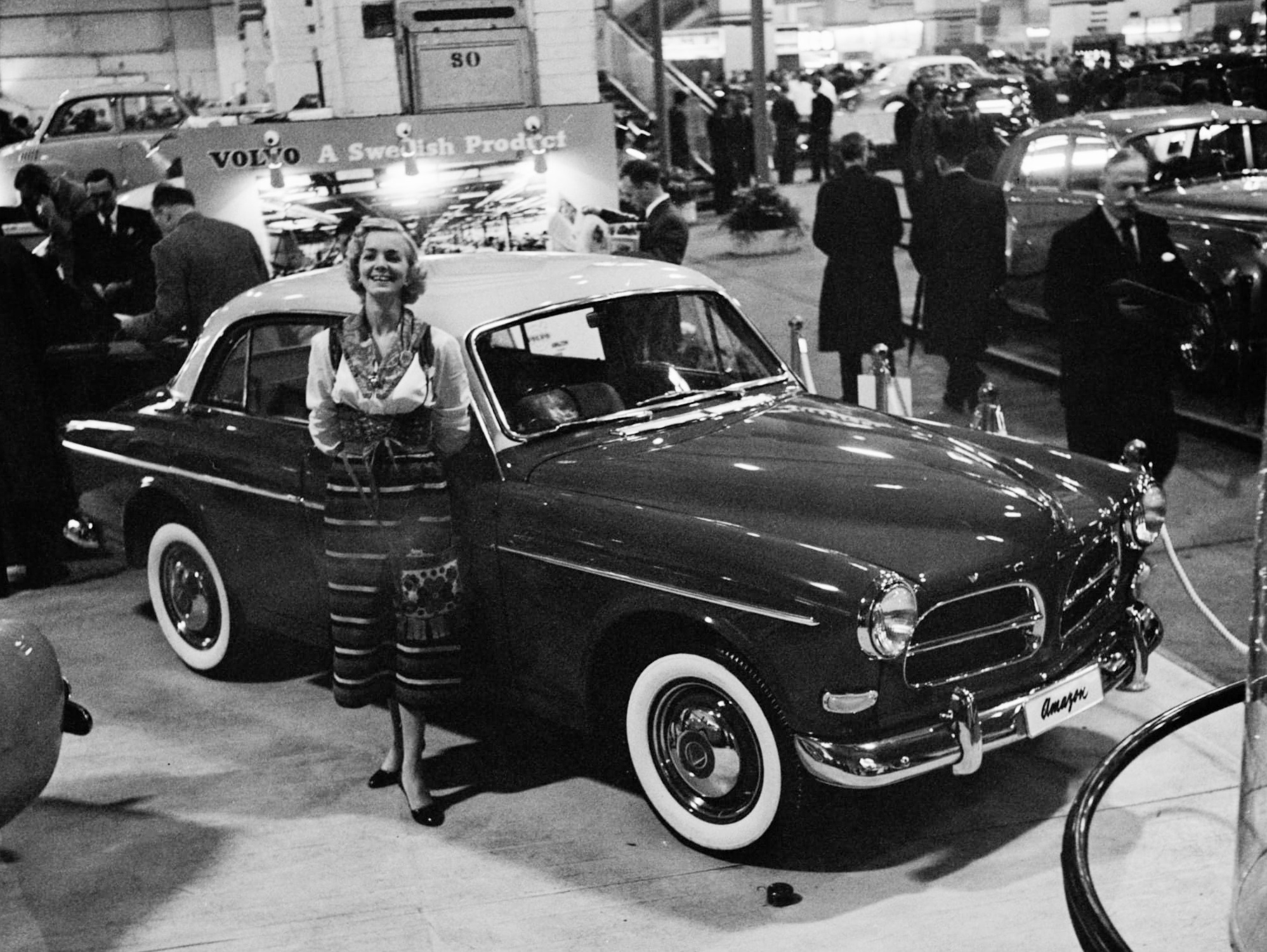
During 1958 the volumes of produced Volvo Amazons starts to increase and the competition, mainly Opel and Volkswagen, are more and more frequent looked at through the rear view mirror. Until 1958 the Volvo Amazon was not covered by the five year car damage warranty that Volvo offered for the PV 444/544. This warranty was introduced on November 1st, 1954 under the name PV warranty and meant that Volvo offered to cover all repair costs above SEK 200 for damages that occurred due to damage or accident. The PV warranty drove a fair part of the PV 444 sales. Volvo was brought into court for this warranty as they were considered to run illegal insurance business and Volvo’s CEO Assar Gabrielsson is personally accused. The case makes its way through the judicial system before the High Court dismisses it in September 1958. Volvo immediately extends the warranty to include the Volvo Amazon, which combined with the fact that the car now has that fourth gear and that several of the initial problems have been addressed lead to immediate increased sales.
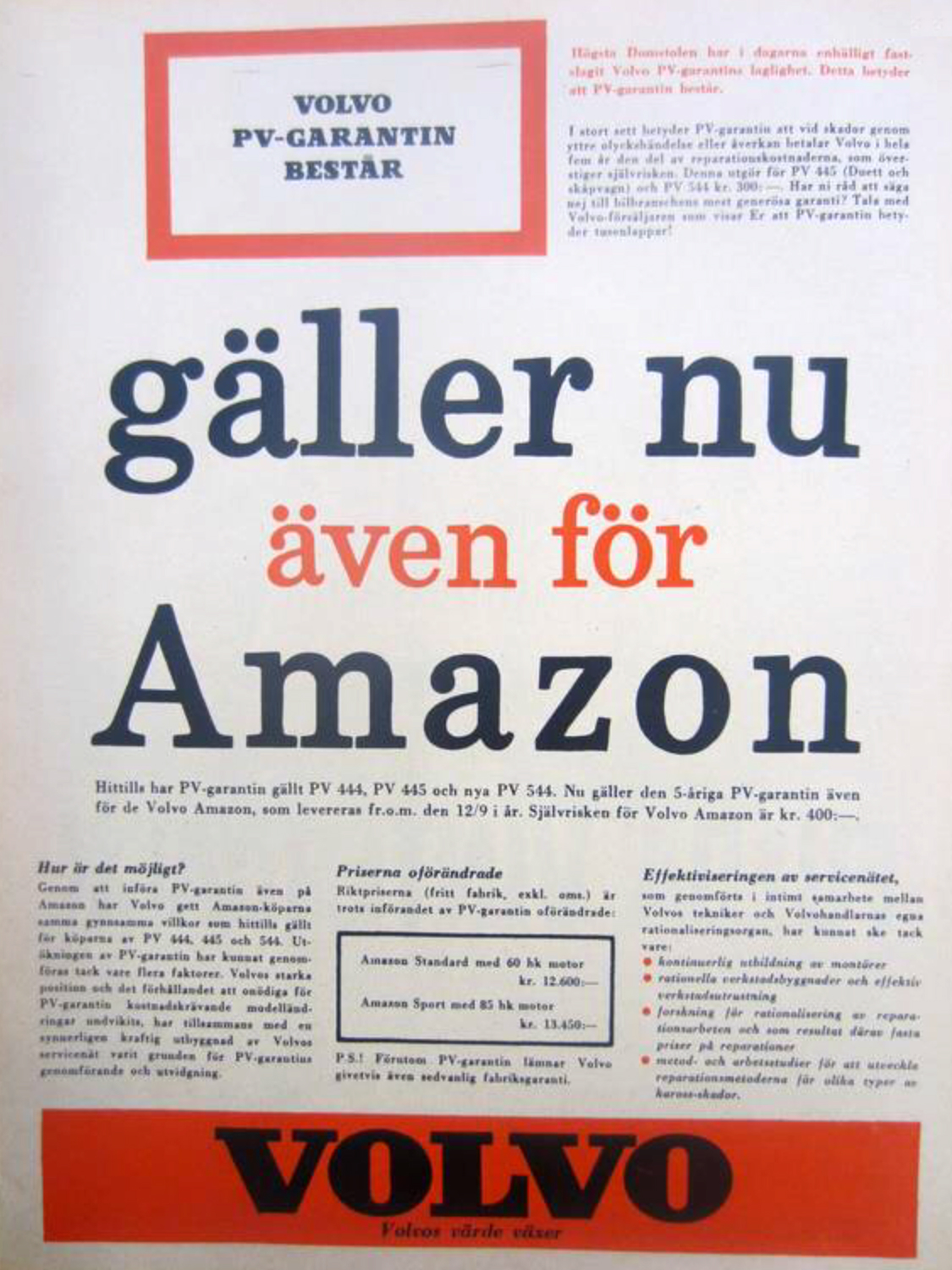
The export of the Volvo Amazon to Denmark starts after the summer of 1957 and if sales initially are poor they are boosted a few months later when Volvo presents a new Amazon to Princess Margrethe (later Queen of Denmark) on her 18th birthday on April 16th, 1958. The car is singletoned and of course Royal Blue (paint code 31). It is registered for traffic only a few days later with license plate KA 20.121, a number reused on several Volvo Amazons delivered to the Royal Danish Court. Soon after, the export of the Amazon boosts and when sales in the USA starts in 1959 it is priced at USD 2,895. During the 1960s Volvo establish assembly plants outside Sweden for the Amazon. From 1963 Volvo has an assembly plant in Dartmouth, Canada (later moved a few miles to Halifax) and from 1965 an assembly plant also in Ghent, Belgium (VENV). Before that, assembly of the Volvo Amazon also took place in Arica, Chile and in Durban, South Africa but these plants were without ownership from Volvo. Through the establishment of the Dartmouth plant Volvo becomes the first European car manufacturer with production in North America.
Product Development
Assar Gabrielsson is succeeded by Gunnar Engellau (from Volvo Aero) as CEO in 1956 but remains in the company as chairman of the board until he passes away on May 28th, 1962. Gustaf Larson holds the position as chief engineer and deputy CEO until 1952, when he takes a seat in the board which he holds until his retirement in 1958. He continues consulting for Volvo until he passes away on July 4th, 1968. When Gunnar Engellau takes over as CEO at Volvo after Assar Gabrielsson on August 13th 1956 and for the first time meets the staff he opens his speech with the legendary words: ”I take my hat off for what has been accomplished, but I take off my coat for the future.”
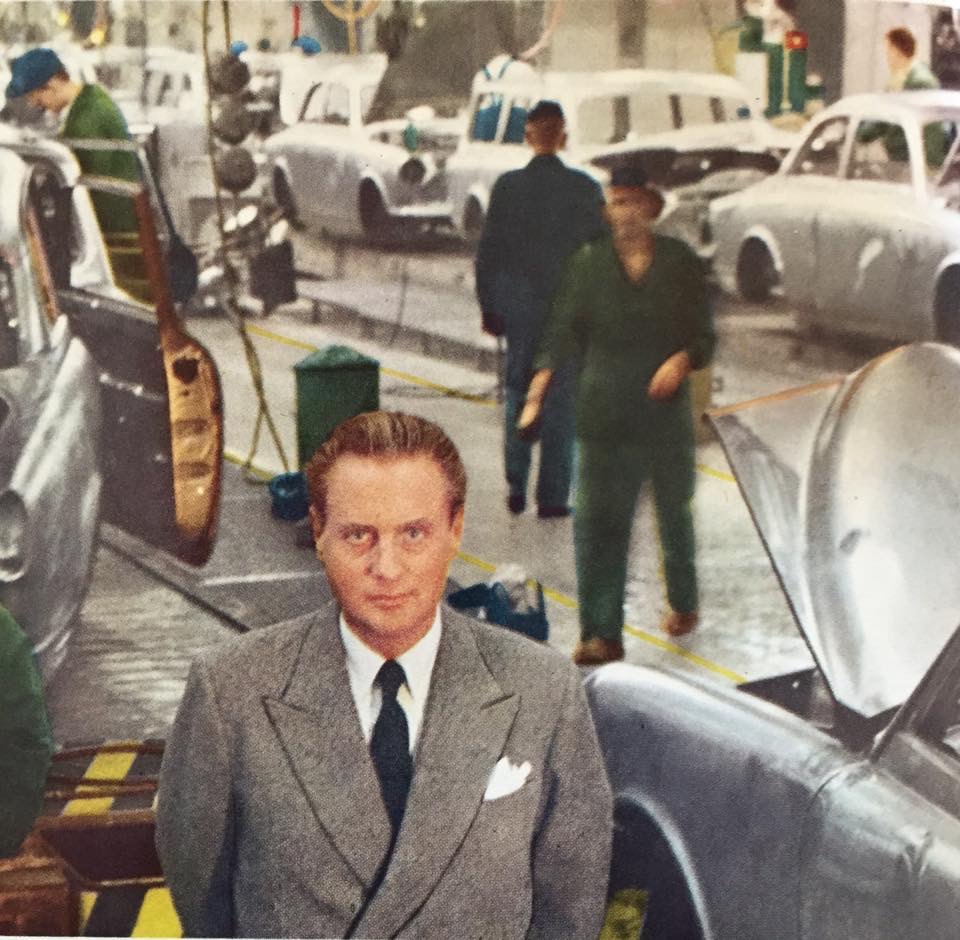
The coming years reflects many changes to the car, many of them being well needed improvements. In 1962 Volvo introduces the two door sedan (by many percieved as a sportier choice) and the Estate; this model year also reveals the eventually legendary B18 engine. In perspective, few industrial products have played a bigger role for Sweden than Volvo Amazon. The predecessor Volvo PV 444 lit up an interest for Swedish made cars abroad, but it is the Amazon that becomes the first major export success. The amount of money brought back to Sweden is substantial. Also on it’s own home market it is the most sold car for several years. It is the success with Volvo Amazon that provides Volvo with the possibilities to invest in new factories, in a new technical center and in new products (like the P 1800, the 140 and the 164). Only in Sweden some 297,000 units are sold during the fourteen years of production. Many of them are still rolling today, over 50 years later.
With the 1965 model year more fundamental changes are introduced on the car. In 1966 the standard version Volvo Amazon Favorit is introduced on some markets, including Scandinavia, as a less expensive alternative and also as a compensation for the by now discontinued PV 544. In 1967 the top of the line version Volvo 123 GT is introduced. Product development of the Volvo Amazon ceases in 1968, more and more assets are relocated to the 140-series and the last two model years bring many simplifications.
On a hot summer day in July 1970 chassis number 359726 is manufactured, which will come to be the last – a dark blue two door sedan. By now, production has lasted for fourteen years and the 140-series will now take over all Amazon production assets. The last Amazon is priced at approximately USD 3,300 in Sweden of which USD 750 constitutes accis and tax. The first was priced at USD 2,630 back in 1956, of which USD 195 was accis and tax. Jan Wilsgaard, who came to Sweden from Norway during the war, didn’t come to retire until the mid 1990s and held the job of chief designer at Volvo for several decades being overall responsible for the design of all Volvo cars from the Amazon to (and including) the 850-series. As bonus for the work with the Volvo Amazon he received three monthly salaries. Jan Wilsgaard passed away on August 6th, 2016.
Some mile stones:
- Production start in August 1956
- New gearbox M4 introduced in February 1958
- Volvo Amazon Sport with the B16 B engine in March 1958
- Complete underseal treatment standard in November 1958
- Factory installed front three-point seatbelts in 1959 (a Volvo invention)
- New gearboxes M30, M31 and M40 in August 1960, M41 in May 1961
- B18 engine introduced in August 1961
- Front disc brakes on 122 S in August 1961
- Two door sedan (initially only in black) in October 1961
- Amazon Estate in production February 1962
- Front disc brakes on all editions in August 1964
- The new Volvo seat is introduced in August 1964
- Output raised in B18 D to 95 hp (SAE) in August 1965
- Output raised in B18 A to 85 hp (SAE), in B18 D to 100 hp (SAE) in August 1966
- 123 GT with B18 B of 115 hp (SAE) in August 1966
- Factory installed headrests in front seats in August 1967
- Factory installed seatbelts in rear seat in August 1967
- Power brakes in August 1967
- B20 engine and dual circuit triangular brake system in August 1968
- Last Amazon produced in Sweden on Friday, July 3rd, 1970
- Last Amazon produced ever in South Africa on Friday, December 18th, 1970
The last Amazon produced in Sweden was saved and can be seen at the Volvo museum in Arendal outside Gothenburg. Volvo’s founders Assar Gabrielsson and Gustaf Larson were both totally uninterested of the history of the company, and in particular Assar Gabrielsson was of the meaning that all focus should be on the future and not on the past. Not until after the founders had passed away did Volvo start collecting historical material in a more structured way.
There are Swedish cars that have been manufactured for longer periods of time and in larger volumes than Volvo Amazon. There are cars that are neater, faster, more safe… …whatever you want. But despite of that Volvo Amazon is The Swedish Car. Volvo’s immortal car has not been in production for over 30 years, but is still considered as a good used buy. Its sport editions 122 S and 123 GT are hard to find and expensive rarities. Already a classic and a collector item.
| Model | Production run | Qty built | Doors | Displacement [cm3] | Output [hp (SAE)] |
| P 1200 | 1956 – 1957 | 248 | 4 | 1,583 | 60 |
| P 1200 V/H | 1957 – 1958 | 4,936 | 4 | 1,583 | 60 |
| P 1200 VB/HB | 1958 | 6,898 | 4 | 1,583 | 60 |
| P 12204 VB/HB | 1958 | 2,918 * | 4 | 1,583 | 85 |
| P 12206 VB/HB | 1958 | 4 | 1,583 | 85 | |
| P 12104 VB/HB | 1958 | 4 | 1,583 | 60 | |
| P 12104 UVB/UHB | 1958 – 1959 | 39,399 ** | 4 | 1,583 | 60 |
| P 12106 UVB/UHB | 1958 – 1959 | 4 | 1,583 | 60 | |
| P 12204 UVB/UHB | 1958 – 1959 | 4 | 1,583 | 85 | |
| P 12206 UVB/UHB | 1958 – 1959 | 4 | 1,583 | 85 | |
| P 120 VD/HD | 1960 – 1961 | 29,900 | 4 | 1,583 | 60 / 85 |
| P 120 VE/HE | 1961 – 1962 | 28,500 | 4 | 1,778 | 75 / 90 |
| P 120 VF/HF | 1962 – 1963 | 27,200 | 4 | 1,778 | 75 / 90 |
| P 120 VG/HG | 1963 – 1964 | 26,400 | 4 | 1,778 | 75 / 90 |
| P 120 VK/HK | 1964 – 1965 | 27,400 | 4 | 1,778 | 75 / 90 |
| P 120 VL/HL | 1965 – 1966 | 31,250 | 4 | 1,778 | 75 / 90 |
| P 120 VM/HM | 1966 – 1967 | 9,160 *** | 4 | 1,778 | 75 / 90 |
| P 130 VA/HA | 1961 – 1962 | 10,499 | 2 | 1,778 | 75 |
| P 130 VB/HB | 1962 – 1963 | 29,500 | 2 | 1,778 | 75 |
| P 130 VD/HD | 1963 – 1964 | 44,600 | 2 | 1,778 | 75 / 90 |
| P 130 VE/HE | 1964 – 1965 | 59,800 | 2 | 1,778 | 75 / 90 |
| P 130 VF/HF | 1965 – 1966 | 72,550 | 2 | 1,778 | 75 / 90 |
| P 130 M | 1966 – 1967 | 62,950 | 2 | 1,778 | 85 / 100 / 115 |
| P 130 P | 1967 – 1968 | 32,600 | 2 | 1,778 | 85 / 115 |
| P 130 S | 1968 – 1969 | 27,500 | 2 | 1,986 | 90 / 118 |
| P 130 T | 1969 – 1970 | 19,919 | 2 | 1,986 | 90 / 118 |
| P 220 VA/HA | 1962 | 1,399 | 5 | 1,778 | 75 |
| P 220 VB/HB | 1962 – 1963 | 6,875 | 5 | 1,778 | 75 |
| P 220 VD/HD | 1963 – 1964 | 9,675 | 5 | 1,778 | 75 |
| P 220 VE/HE | 1964 – 1965 | 11,450 | 5 | 1,778 | 75 |
| P 220 VF/HF | 1965 – 1966 | 15,200 | 5 | 1,778 | 75 / 95 |
| P 220 M | 1966 – 1967 | 17,200 | 5 | 1,778 | 85 / 100 |
| P 220 P | 1967 – 1968 | 8,500 | 5 | 1,778 | 85 / 115 |
| P 220 S | 1968 – 1969 | 2,897 **** | 5 | 1,986 | 90 |
* Refers to total units P 12104, P 12204 and P 12206 manufactured during production run 1958.
** Refers to total units P 12104, P 12106, P 12204 and P 12206 manufactured during production run 1958 – 1959. P 12208 is missing in the table but is included in the numbers.
*** Incorrect number; should be 9,604 according to Volvo’s own delivery books which gives a total number of 234,653 produced P 120.
**** Incorrect number; should be 2,921 according to Volvo’s own delivery books which gives a total number of 73,220 produced P 220.
From Volvo’s magazine Ratten number 4, 1981. Note that Volvo here present incorrect figures regarding the engine output in the B16 A, which according to B16 A owners as well as contemporary Volvo literature is 66 hp (SAE). The table also contain a couple of incorrect production figures (marked) which do not match Volvo’s own production cards. Production run is not the same as model year. Some editions were available on some markets earlier than stated here, for instance P 220 in 122 S edition.